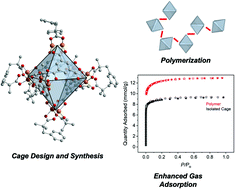Synthesis, characterization, and polymerization of capped paddlewheel porous cages†
Abstract
Although paddlewheel-based structures are common among permanently porous metal–organic materials, suitable strategies for the isolation of metal node-terminated, capped paddlewheel-based cage structures remain limited. We explored the use of chelating dicarboxylate ligand derivates (esp) for the isolation of trimesate-linked cages, Mo12(btc)4(esp)6, that are structural analogs of the small octahedral pore of HKUST-1. The porosity of these novel cages is appreciably higher than that of previously reported structures of this type. We also demonstrate that pillaring the isolated cage with DABCO generated an amorphous polymer that featured exceptional thermal stability and enhanced porosity.



 Please wait while we load your content...
Please wait while we load your content...
